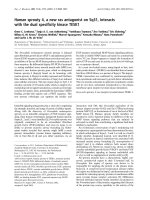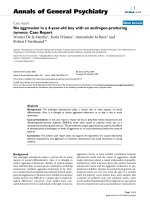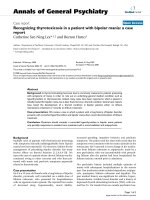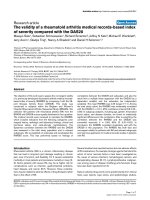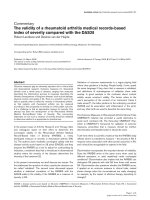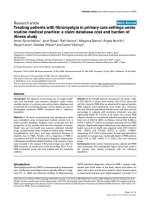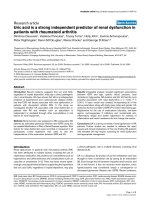Báo cáo y học: " Oral vaccination with a recombinant Salmonella vaccine vector provokes systemic HIV-1 subtype C Gag-specific " ppt
Bạn đang xem bản rút gọn của tài liệu. Xem và tải ngay bản đầy đủ của tài liệu tại đây (306.49 KB, 9 trang )
BioMed Central
Page 1 of 9
(page number not for citation purposes)
Virology Journal
Open Access
Research
Oral vaccination with a recombinant Salmonella vaccine vector
provokes systemic HIV-1 subtype C Gag-specific CD4+ Th1 and Th2
cell immune responses in mice
Nyasha Chin'ombe
1
, William R Bourn
1,4
, Anna-Lise Williamson
1,2
and
Enid G Shephard*
1,3
Address:
1
Institute of Infectious Disease and Molecular Medicine, Faculty of Health Sciences, University of Cape Town, Observatory 7925, Cape
Town, South Africa,
2
National Health Laboratory Services, Groote Schuur Hospital, Cape Town, South Africa,
3
Department of Medicine, Faculty
of Health Sciences, University of Cape Town, Observatory 7925, Cape Town, South Africa and
4
Kapa Biosystems (Pty) Ltd, Observatory 7925, Cape
Town, South Africa
Email: Nyasha Chin'ombe - ; William R Bourn - ; Anna-
Lise Williamson - ; Enid G Shephard* -
* Corresponding author
Abstract
Background: Recombinant Salmonella vaccine vectors may potentially be used to induce specific
CD4+ T cell responses against foreign viral antigens. Such immune responses are required features
of vaccines against pathogens such as human immunodeficiency virus type 1 (HIV-1). The aim of this
study was to investigate the induction of systemic HIV-1-specific CD4+ T helper (Th) responses in
mice after oral immunization with a live attenuated Salmonella vaccine vector that expressed HIV-
1 subtype C Gag. Groups of BALB/c mice were vaccinated orally three times (4 weeks apart) with
this recombinant Salmonella. At sacrifice, 28 days after the last immunization, systemic CD4+ Th1
and Th2 cytokine responses were evaluated by enzyme-linked immunospot assay and cytometric
bead array. HIV-1 Gag-specific IgG1 and IgG2a humoral responses in the serum were determined
by enzyme-linked immunosorbent assay.
Results: Mice vaccinated with the recombinant Salmonella elicited both HIV-1-specific Th1
(interferon-gamma (IFN-γ) and tumour necrosis factor-alpha (TNF-α)) and Th2 (interleukin-4 (IL-
4) and interleukin-5 (IL-5)) cytokine responses. The vaccine induced 70 (IFN-γ) spot-forming units
(SFUs)/10e6 splenocytes and 238 IL-4 SFUs/10e6 splenocytes. Splenocytes from vaccinated mice
also produced high levels of Th1 and Th2 cytokines upon stimulation with a Gag CD4 peptide. The
levels of IFN-γ, TNF-α, IL-4 and IL-5 were 7.5-, 29.1-, 26.2- and 89.3-fold above the background,
respectively. Both HIV-1 Gag-specific IgG1 and IgG2a antibodies were detected in the sera of
vaccinated mice.
Conclusion: The study highlights the potential of orally-delivered attenuated Salmonella as
mucosal vaccine vectors for HIV-1 Subtype C Gag to induce Gag-specific CD4+ Th1 and Th2
cellular immune responses and antibodies which may be important characteristics required for
protection against HIV-1 infection.
Published: 25 June 2009
Virology Journal 2009, 6:87 doi:10.1186/1743-422X-6-87
Received: 30 April 2009
Accepted: 25 June 2009
This article is available from: />© 2009 Chin'ombe et al; licensee BioMed Central Ltd.
This is an Open Access article distributed under the terms of the Creative Commons Attribution License ( />),
which permits unrestricted use, distribution, and reproduction in any medium, provided the original work is properly cited.
Virology Journal 2009, 6:87 />Page 2 of 9
(page number not for citation purposes)
Background
Attenuated Salmonella bacterial vaccines may be exploited
for use as vectors for the oral delivery of HIV-1 antigens to
both the mucosal and systemic compartments of the
immune system. The bacteria provoke potent mucosal
and systemic immune responses when administered by
the oral route [1-4]. After oral administration, the bacteria
are taken-up by professional phagocytes in the gut; they
can then spread throughout the intestinal lymphatic tis-
sues and reach the systemic compartments such as the
liver and the spleen. In the phagocytes, the bacteria are
found in Salmonella-containing vacuoles, or phagosomes,
and the antigens are predominantly targeted to the MHC
Class II presentation pathway, thereby provoking mainly
the CD4+ Th1 and Th2 responses [5]. The induction of
antigen-specific CD4 Th1 and Th2 responses is important
for protection against infection by various types of patho-
gens. CD4+ Th1 cells produce cytokines such as IFN-γ, IL-
2 and TNF-α, while CD4+ Th2 cells produce cytokines
such as IL-4 and IL-5 [6-8]. In the case of viral infection,
CD4+ Th1 and Th2 cells play a critical role in maintaining
CD8+ T cell and antibody responses, respectively [9,10].
These cells are, therefore also indirectly important in their
control of viral replication and vireamia [11]. In the
present study, we investigated the induction of systemic
antigen-specific CD4+ Th1 and Th2 cell responses in mice
that had been orally vaccinated with a recombinant Sal-
monella enterica serovar Typhimurium aroC vaccine vector
that expressed codon-optimized HIV-1 subtype C Gag
antigen.
Methods
Bacterial strains and culture conditions
Escherichia coli SCS110 cells (Stratagene, USA) were used
for genetic manipulations and cloning. The Salmonella
enterica serovar Typhimurium ΔaroC mutant vaccine
strain (TML-MD58) was supplied by Microscience Pty Ltd
(United Kingdom). This mutant has a deletion in the aroC
gene, which encodes chorismate synthase, an enzyme that
is crucial for the biosynthesis of tryptophan, tyrosine, phe-
nylalanine, para-aminobenzoic acid and 2,3-dihydroxy-
benzoate [12]. 2YT media (supplemented, where
necessary, with ampicillin and the aromatic amino acids)
was used for culture of the recombinant Salmonella.
Construction of a Gag expression cassette
To construct the Salmonella Gag-expression plasmid, a
codon-optimized HIV-1 gag gene, synthesized for us by
Geneart (USA), was cloned by standard recombinant
DNA protocols [13] into pGEM+GFP, a plasmid designed
to express green fluorescent protein that we previously
constructed [14]. The gfp gene in pGEM+GFP was replaced
with the gag gene and the plasmid designated pGEM+Gag
was generated. The expression of Gag was under the con-
trol of the E. coli lac (lactose) promoter. Competent ΔaroC
Salmonella enterica serovar Typhimurium mutant was
transformed with the expression plasmid (pGEM+Gag)
and this resulted in the generation of a recombinant Sal-
monella vaccine clone, designated, aroC+Gag. The parent
cloning vector, pGEM
®
-T Easy (Promega), was used as a
negative control plasmid to generate a vaccine designated
aroC+pGEM. The expression of HIV-1 Gag in the recom-
binant Salmonella bacteria, aroC+Gag, was assessed by
SDS-PAGE according to standard protocols. The expres-
sion of the Gag protein was further confirmed using the
Roche Elecsys
®
HIV p24 Ag assay (Roche) according to
manufacturer's recommendations.
Salmonella vaccine stocks
Stocks of recombinant Salmonella bacterial vaccines were
prepared from culture colonies of AroC+Gag (test vac-
cine) or aroC+pGEM (negative control vaccine). A single
colony was inoculated into 200 ml of 2YT liquid media
supplemented with ampicillin (100 μg/ml) and aromatic
amino acids and grown at 37°C with vigorous aeration.
The bacterial cells were harvested when they reached log-
arithmic phase (OD
600
of 0.8) by centrifugation and
washed once with PBS (pH 7.4). The vaccine was sus-
pended in PBS with 15% glycerol and stored at -80°C
prior to use for immunization.
Immunization of mice and preparation of splenocytes
Animal work was approved by the University of Cape
Town Animal Ethics Committee. Female H-2
d
BALB/c
mice (8–10 weeks old) were purchased from South Afri-
can Vaccine Producers (Johannesburg, South Africa) and
were housed (5 per group) at the University of Cape Town
Animal Unit. The mice were allowed to adapt to the new
environment for at least 10 days before immunization.
They were bled on day 0 prior to being inoculated by
intragastric gavage with 1 × 10e8 colony forming units
(CFUs)/mouse of either the Salmonella test vaccine
(aroC+Gag) or the negative control (aroC+pGEM) and
again on days 28 and 56 prior to the booster Salmonella
vaccine being given. Blood was also taken on day 84 just
prior to sacrifice of the mice for harvest of spleens. Serum
was collected and used in ELISA assays to measure Gag-
specific antibody responses.
Spleens were harvested from the mice at sacrifice on day
84. A pool of 5 spleens per group was made, then passed
through a 70-μm cell strainer to obtain a single cell sus-
pension of splenocytes. Splenocytes were suspended in
R10 medium (RPMI-1640 with 10% heat inactivated fetal
calf serum, 15 mM β-mercaptoethanol, 100 U penicillin
and 100 μg streptomycin per ml). Red cells were lysed
using erythrocyte lysing solution (0.15 M NH
4
Cl, 10 mM
KHCO
3
, 0.1 mM Na
2
EDTA). The splenocytes were sus-
pended at a concentration of 5 × 10e6 cells per ml for use
in enzyme-linked immunospot (ELISPOT) assays or at a
Virology Journal 2009, 6:87 />Page 3 of 9
(page number not for citation purposes)
concentration of 15 × 10e6 cells per ml for stimulation
with Gag peptides to quantify Gag-specific cytokines
released into the supernatant.
IFN-
γ
and IL-4 ELISPOT assays
Gag-specific CD4+ T cells secreting IFN-γ or IL-4 in the
spleen were enumerated using IFN-γ and IL-4 ELISPOT
assay kits (BD Pharmingen) as previously described [15].
Briefly, splenocytes were cultured in triplicate wells at 0.5
× 10e6 cells/well in a final volume of 200 μl with either
R10 medium only (background responses) or R10
medium containing the Gag CD4 peptide (NPPIPVGDI-
YKRWIILGLNK, an MHC class II-restricted, CD4 binding
peptide) at 4 μg/ml. After incubation (37°C, 5% CO
2
) for
24 hours (IFN-γ ELISPOT assay) or 48 hours (IL-4 ELIS-
POT assay), the cells secreting IFN-γ or IL-4 were detected
using Nova Red substrate (Vector Labs) according to the
manufacturer's instructions. Spots were counted using
CTL Analyzer and ImmunoSpot Version 3.2 software
(Cellular Technology, USA). The mean number of spots ±
SD in triplicate wells was calculated and expressed as spot-
forming units (SFU) per 10e6 splenocytes. Differences in
immune responses between vaccine groups were analyzed
by a two-sample student's t-test. A p < 0.05 was considered
statistically significant. The differences in response
between stimulated cells and unstimulated cells within
the same vaccine group were also analyzed by a student's
t-test and p < 0.05 was considered statistically significant.
Quantification of Gag-specific CD4+ Th1 and Th2
cytokine production
Splenocytes (1.5 × 10e6) were cultured (37°C, 5% CO
2
)
in a final volume of 200 μl R10 medium only (back-
ground responses) or R10 medium containing the Gag
CD4 peptide (as used in the ELISPOT assays) at 4 μg/ml
[15]. Culture supernatants were harvested at 48 hours and
the content of Gag-specific Th1 cytokines (IFN-γ and TNF-
α) and Th2 cytokines (IL-4 and IL-5) were quantified
using a mouse Th1/Th2 Cytokine Bead Array (CBA) assay
(BD Pharmingen) according to manufacturer's instruc-
tions. Results were expressed as pg cytokine per 10e6
splenocytes. Differences in immune responses between
vaccine groups were analyzed by a two-sample student's t-
test and p < 0.05 was considered statistically significant.
The differences in response between stimulated cells and
unstimulated cells within the same group were also ana-
lyzed by a student's t-test and p < 0.05 was considered sta-
tistically significant.
HIV-1 Gag antibody assay
Antibodies (total IgG) to HIV Gag were detected in mouse
serum (pooled from 5 mice per group) collected on day 0,
28, 56 and 84 and Gag-specific IgG1 and IgG2a detected
at day 84 using HIV-1 Gag (P55) enzyme linked immuno-
sorbent assay (ELISA). Briefly, flat-bottom, 96-well Max-
iSorp ELISA plates (AEC-Amersham) were coated with 50
μg of HIV-1 P55 (Quality Biological Inc. USA) in 50 μl 0.1
M bicarbonate buffer (pH 9.5) overnight at 4°C. Plates
were washed with PBS-Tween (PBS containing 0.3%
Tween 20, Merck) and blocked with blocking solution
(PBS containing 0.3% Tween 20, 1% goat serum, 3% milk
powder) overnight at 4°C. Mouse serum samples were
diluted (1/100), and 100 μl added to duplicate wells and
the reaction incubated overnight at 4°C. After washing
with PBS-Tween containing 1% goat serum and 1% milk
powder, total Gag (P55)-specific IgG, was detected by the
addition of 100 μl/well of biotinylated goat anti-mouse
IgG (Southern Biotechnology, Birmingham, AL). After
incubation at 37°C for 2 hours, plates were washed with
PBS-Tween and streptavidin-alkaline phosphatase (50 μl/
well) was added and the plates incubated a further 1 hour
at 37°C. To detect HIV-1 Gag (P55)-specific IgG1 and
IgG2a isotypes, alkaline phosphatase-conjugated anti-
bodies specific for IgG1 or IgG2a) (Serotec) were used.
Alkaline phosphatase was reacted with 50 μl/well para-
nitrophenyl phosphate (PNP) diluted to a final concen-
tration of 1 mg/ml. The optical density (OD) was read at
405 nm and means of duplicates was calculated. For total
IgG, the ratios of vaccinated to prebleed were calculated
and represented graphically. The OD readings were repre-
sented graphically for IgG1 and IgG2a. Differences in
immune responses between vaccine groups were analyzed
by a two-sample student's t-test and a p value < 0.05 was
considered statistically significant.
Results
Construction of a codon-optimized HIV-1 Gag-expressing
Salmonella vaccine vector
A prokaryotic expression plasmid that contained a wild-
type HIV-1 Subtype C gag gene was initially constructed.
As Gag expression was poor, probably because of the
presence of bacterial rare codons (data not shown), we
redesigned the recombinant vaccine. For this the wild-
type HIV-1 gag gene was replaced with a synthesised gene
that reflected codon usage in Salmonella and the expres-
sion plasmid, pGEM+Gag, containing the codon-opti-
mized gag was successfully constructed (Figure 1A). The
plasmid contained the HIV-1 gag gene fused to the β-
galactosidase α-fragment and the expression was consti-
tutively driven by the E. coli lac promoter and other lac
operon transcription and translation domains found in
pGEM-Teasy plasmid. The recombinant plasmid-carry-
ing Salmonella expressed very high levels of HIV Gag (Fig-
ure 1B). The Gag protein band was visible in Coomassie
blue-stained SDS-PAGE gels (Figure 1B, Lane 2). The
high-level of Gag protein expressed by the Salmonella was
further confirmed by Roche Elecsys
®
HIV p24 Ag Capture
assay (Figure 1C). The expression of codon-optimized
Gag was higher than previously found with wild-type
Gag (data not shown).
Virology Journal 2009, 6:87 />Page 4 of 9
(page number not for citation purposes)
Oral vaccination of mice with a recombinant Salmonella
induces Th1 and Th2 cytokine producing CD4+ T cells
CD4+ Th1/Th2 T cells induced in the spleens of mice in
response to oral vaccination with the recombinant codon-
optimized HIV-1 Gag-expressing Salmonella vaccine vec-
tor, aroC+Gag, were evaluated using ELISPOT assays. Mice
vaccinated with aroC+Gag developed HIV-1 Gag-specific
CD4+ Th1 (IFN-γ) and Th2 (IL-4) cells in the spleen. The
frequency of Gag-specific IFN-γ spot-forming units from
aroC+Gag was above the background (p < 0.05) (Figure
2A). Cells from the aroC+Gag group responded to Gag
CD4 peptide stimulation. The number of IL-4-producing
cells from aroC+Gag was also significantly higher than the
number of cells producing IL-4 from the negative vaccine
control (p < 0.05) (Figure 2B). It was, therefore, evident
that both Gag-specific IFN-γ and IL-4 cytokines were elic-
ited by the recombinant Salmonella vaccine vector.
A CBA assay was used to quantify Gag-specific IFN-γ, TNF-
α, IL-4 and IL-5 cytokines secreted by the splenocytes
upon antigenic stimulation. The amounts of CD4+ Th1
(INF-γ and TNF-α) and Th2 (IL-4 and IL-5) cytokines
secreted by the splenocytes into the supernatant were
quantified. The levels of Gag-specific Th1 and Th2
cytokines were all significantly elevated above the back-
ground (p < 0.05) (Figure 3) in mice vaccinated with
aroC+Gag. The levels of Th1 cytokines, IFN-γ and TNF-α
were 7.5-fold and 29.1-fold above the background,
respectively (Figure 3A and 3B). The Th2 cytokine levels,
IL-4 and IL-5 were 26.2- and 89.3-fold above the back-
ground, respectively (Figure 3C and 3D). The CBA results,
therefore, confirmed that vaccination of mice orally with
the Salmonella vaccine vector induced systemic Gag-spe-
cific Th1 and Th2 cytokine responses.
Oral vaccination of mice with recombinant Salmonella
induces Gag-specific antibodies
HIV-1 Gag-specific humoral immune responses in mice
vaccinated with the HIV Gag-expressing Salmonella vac-
cine were evaluated on days 28, 56 and 84. Anti-Gag total
IgG and IgG subtypes IgG2a and IgG1 in the serum of vac-
cinated mice were determined. A very low serum HIV-1
Gag specific IgG response (1.52-fold OD
405
reading above
prebleed) was detected on day 28 in serum (1/100 dilu-
tion) in mice vaccinated with aroC+Gag and this was not
significantly above the control (p > 0.05) (Figure 4A). On
day 56, the antibody response was boosted significantly
(5-fold OD
405
reading above prebleed) (p < 0.05). The
Gag-specific antibody response was further boosted by
day 84 (22-fold OD
405
reading above prebleed) (p < 0.05)
(Figure 4A). HIV-1 Gag-specific IgG responses were con-
firmed using the New LAV Blot I HIV-1 Western blotting
kit (Biorad). The serum from the aroC+Gag-vaccinated
mice reacted specifically with Gag bands (P55, P40, P24/
25 and P17/18) on the blot (results not shown). Gag-spe-
The HIV-1 subtype C Gag expression plasmid (pGEM+Gag) and Gag expression by SalmonellaFigure 1
The HIV-1 subtype C Gag expression plasmid
(pGEM+Gag) and Gag expression by Salmonella. (A)
The HIV Gag expression cassette contained the gag gene
fused in-frame with the β-galactosidase α-gene and expres-
sion was under the E. coli lac (lactose) promoter. The plasmid
contained an E. coli origin of replication (ori) and ampicillin
resistance gene (AmpR). (B) The relative expression of the
Gag by the recombinant Salmonella vaccine (aroC+Gag) was
determined by SDS-PAGE and (C) the Roche Elecsys
®
HIV
p24 Ag assay. In the Roche Elecsys
®
HIV p24 Ag assay, total
bacterial protein lysate was diluted 1/1000 in water and the
cut-off index was calculated by the Elecsys
®
2010 analyzer
using readings from the negative and positive calibrators.
pGEM+Gag
.
HIV-1 gag
Plac
AmpR
ori
lacZa
A
B
Gag
Marker
aroC+Gag
aroC+pgem
ar oC+Gag ar oC+pgem
HIV-1 Gag expression
0
1000
2000
Cutoff index
C
Virology Journal 2009, 6:87 />Page 5 of 9
(page number not for citation purposes)
cific serum IgG subtypes measured on day 84 indicated
the presence of significant (p < 0.01) levels of IgG1 and
IgG2a (p < 0.05) (Figure 4B). The Gag-specific Ig2a
response was slightly greater than the IgG1 response. In
summary, both Th2-related IgG1 and Th1-related IgG2a
antibody responses were induced in the mice vaccinated
with the HIV Gag-expressing Salmonella vaccine.
HIV-1 subtype C Gag-specific CD4+ Th1 and Th2 cell responses as evaluated by IFN-γ and IL-4 ELISPOT assaysFigure 2
HIV-1 subtype C Gag-specific CD4+ Th1 and Th2 cell
responses as evaluated by IFN-γ and IL-4 ELISPOT
assays. Groups of mice (5 mice per group) were vaccinated
three times (day 0, 28 and 56) with live recombinant Salmo-
nella vaccine that expressed HIV-1 Subtype C Gag
(aroC+Gag) or an antigen-negative Salmonella control vac-
cine (aroC+pGEM). Mice were sacrificed on day 84, and
splenocytes were prepared from isolated spleens pooled
from 5 mice per group then used in IFN-γ (A) and IL-4 (B)
ELISPOT assays with R10 medium only (negative assay con-
trol) or with the Gag CD4 peptide. Bars are the mean
number of spots from triplicate wells and are expressed as
SFU/10e6 splenocytes. Differences in immune responses
between vaccine groups were analyzed by a two-sample stu-
dent's t-test. A p < 0.05 was considered statistically signifi-
cant. The differences in response between stimulated cells
and unstimulated cells within the same vaccine group were
also analyzed by a student's t-test and a p < 0.05 was consid-
ered statistically significant. A p > 0.05 was considered not
statistically significant (NS).
0
20
40
60
80
100
Media
Gag CD4+
IFN-Ȗ SFUs/10e6 cells
A
aroC+Gag aroC+pgem
p<0.05
p<0.05
NS
IL-4 SFUs/10e6 cells
0
50
100
150
200
250
300
Media
Gag CD4+
B
aroC+Gag aroC+pgem
p<0.05
p<0.05
NS
HIV-1 subtype C Gag-specific CD4+ Th1 and Th2 cell responses as evaluated by the amount of cytokines secreted by stimulated cellsFigure 3
HIV-1 subtype C Gag-specific CD4+ Th1 and Th2 cell
responses as evaluated by the amount of cytokines
secreted by stimulated cells. Groups of mice (5 per
group) were vaccinated with live recombinant Salmonella vac-
cine that expressed HIV-1 Subtype C Gag (aroC+Gag) or
antigen-negative Salmonella control vaccine (aroC+pGEM) as
indicated in Figure 2. Splenocytes isolated and pooled from 5
mice per group on day 84 were incubated in R10 medium
only (negative assay control), or stimulated with a Gag CD4
peptide for 48 hrs. Cytokines released into the supernatant
were quantified using a mouse Th1/Th2 cytokine bead array
(CBA) assay. (A) IFN-γ, (B) TNF-α, (C) IL-4 and (D) IL-5.
Each bar in the graphs represents the average picogram
amount of cytokine produced per 10e6 splenocytes in 48
hours of stimulation with media or Gag CD4 peptide, for
triplicate responses. A p < 0.05 was considered statistically
significant. A p > 0.05 was considered not statistically signifi-
cant (NS).
0
200
400
600
800
Media
Gag CD4+
aroC+Gag aroC+pgem
IFN-Ȗ (pg/10e6 cells
A
p<0.05
NS
p<0.05
0
500
1000
1500
2000
2500
Media
Gag CD4+
aroC+Gag aroC+pgem
TNF-Į (pg/10e6 cells
B
p<0.05
p<0.05
NS
0
200
400
600
800
Media
Gag CD4+
aroC+Gag aroC+pgem
IL-4 (pg/10e6 cells
C
p<0.05
p<0.05
NS
0
100
200
300
400
Media
Gag CD4+
aroC+Gag aroC+pgem
IL-5 (pg/10e6 cells
D
p<0.05
p<0.05
NS
Virology Journal 2009, 6:87 />Page 6 of 9
(page number not for citation purposes)
Discussion
Delivery of heterologous antigens through the mucosal
surface by recombinant Salmonella vectors is a powerful
strategy for inducing both mucosal and systemic immune
responses. After oral vaccination, the Salmonella bacteria
invade the mucosal surfaces and spread through the
mesenteric lymph nodes to distal sites, such as spleen and
liver [16,17]. This normally results in the induction of
both mucosal and systemic cellular and humoral immune
responses [18-20]. In the current study, we investigated
the immunogenicity of a recombinant HIV-1 Subtype C
Gag-expressing attenuated live Salmonella enterica serov-
arTyphimurium vaccine vector in mice after oral immuni-
zation. The HIV-1 gag gene was codon-optimized to
reflect codons commonly used by Salmonella bacteria. The
presence of rare codons in foreign genes may affect mRNA
and plasmid stability and, in some cases, protein synthesis
and bacterial growth [21-24]. In this study, we found that
the expression of the HIV-1 Gag in Salmonella was
improved when the gene was codon-optimized confirm-
ing published data [25]. However, other studies have
shown that the level of antigen expression was decreased
in Salmonella when the gene was codon-optimized [26].
Codon-optimization of genes for expression in recom-
binant Salmonella vaccine vectors has been reported to
have an impact on the nature, breadth and magnitude of
the immune responses induced after vaccination. It has
been shown that antigen-specific immune responses
against a Salmonella-based vaccine that expressed human
papillomavirus type 16 L1 improved after codon-optimi-
zation [26]. The expression of measles virus (MV)
epitopes in a Salmonella vaccine vector has been shown to
be enhanced by codon-optimization [27]. Oral vaccina-
tion of MV-susceptible mice with the recombinant Salmo-
nella vector induced MV-specific serum antibodies and
CD4+ T cell response [26]. Codon-optimization of HIV-1
gag for expression in Salmonella resulted in enhanced
mucosal immunity in vaccinated mice [25].
Our recombinant HIV-1 Gag-expressing Salmonella vac-
cine induced specific Th1 and Th2 cytokine responses in
the spleen. This indicates that the recombinant bacteria
successfully delivered the heterologous HIV-1 antigen to
the systemic immune system after oral vaccination. Live
Salmonella can be taken up by antigen-presenting cells by
the process of phagocytosis and the bacteria are able to
reside and replicate in the phagosomes. The Salmonella
antigens are, therefore, presented to MHC class II-
restricted CD4+ T cells [28-30]. This elicits antigen-spe-
cific Th1 and/or Th2 cytokine responses [31-34]. The two
types of responses (CD4+ Th1 and Th2) induced by the
recombinant Salmonella vector in this study are crucial for
vaccines that are required to induce both cell-mediated
and antibody responses for protection against infection
by a number of pathogens. CD4+ Th1 cytokines such as
IFN-γ and TNF-α provide protective immunity against
intracellular pathogens such as viruses. They promote
CD8+ T cell responses and B cell class-switching to IgG2a
[35,36]. In contrast, CD4+ Th2 cytokines such as IL-4 and
IL-5 promote B cell class switching to neutralizing anti-
bodies such as IgG1 and they further regulate the magni-
HIV-1 subtype C Gag-specific serum IgG responses in mice vaccinated with recombinant Salmonella vaccine vectorFigure 4
HIV-1 subtype C Gag-specific serum IgG responses in
mice vaccinated with recombinant Salmonella vac-
cine vector. Groups of mice (5 per group) were vaccinated
with live recombinant Salmonella vaccine that expressed HIV-
1 Subtype C Gag (aroC+Gag) or an antigen-negative Salmo-
nella control vaccine (aroC+pGEM) as indicated in Figure 2.
Serum (pooled from 5 mice per group) was isolated from
blood taken before each vaccination on day 0, 28 and 56 and
just before sacrifice on day 84. (A) The HIV-1 Gag-specific
IgG for each group of mice with a 1/100 serum dilution. The
data are the ratio of the OD
405 nm
for vaccinated mice and
the OD
405 nm
for the day 0 serum (pre-bleed). (B) The HIV-1
Gag-specific IgG1 and IgG2a were measured in serum of each
group of mice on Day 84 with a 1/100 serum dilution. Each
bar represents the mean OD
405 nm
value. Differences in anti-
body responses between vaccine groups at different time
points were analyzed by a two-sample student's t-test and a p
< 0.05 was considered statistically significant. A p > 0.05 was
considered not statistically significant (NS).
0
5
10
15
20
25
30
aroC +Gag aroC +pGEM
R atio to p re b lee d
Day 28
Day 56
Day 84
A
NS
p<0.05
p<0.05
0
0.5
1
1.5
aroC+Gag aroC+pGEM
Ig G 1
Ig G 2a
OD at 405nm
p<0.05
p<0.05
B
Virology Journal 2009, 6:87 />Page 7 of 9
(page number not for citation purposes)
tude of Th1 cytokine responses [36-38]. In this study, we
also tested for the induction of Gag-specific CD8+ T cells
in vaccinated mice. No specific CD8+ T cells were detecta-
ble by ELISPOT and CBA assays (results not shown). This
was not unexpected; the secretion of antigens from the
Salmonella bacteria has been shown to result in induction
of antigen-specific CD8+ T cell responses in vaccinated
mice [39-41]. Our HIV-1 Gag antigen was expressed
inside the bacterial cytoplasm as inclusion bodies and was
therefore unlikely to induce potent antigen-specific CD8+
T cell responses.
The nature of immune responses found in this study has
relevance to the field of HIV-1 vaccinology. In HIV-1
infection, CD4+ Th1 and Th2 cells play regulatory roles in
controlling infection and replication [42,43]. HIV-
infected long-term non-progressors have been found to
have strong CD4+ T cell responses to HIV-1 antigens such
as Gag [44]. Recent studies have also suggested that HIV-
specific CD4+ Th1 cell that produce INF-γ and IL-2 are
important in long-term reduction of HIV viremia [45,46].
Other studies have shown that the loss of CD8+ T cell
responses in HIV-1 infection could be reversed by vaccine-
induced CD4+ Th cell responses [47]. Although CD4+ Th
cells provide immunological help to CD8+ T cells and B
cells, they can also play a more direct role in antiviral
activity [48]. CD4+ T cells, like CD8+ T cells, have cyto-
lytic activities against HIV-infected cells and can provide
protective immune responses [49-52]. The cytokines, such
as IFN-γ and TNF-α, secreted by activated CD4+ T cells
have direct antiviral activities [53]. HIV-1 vaccines should,
therefore, provoke both specific CD8+ and CD4+ T cell
responses, so as to maximize the chance of preventing or
controlling infection.
The development of an HIV-1 vaccine that elicits protec-
tive humoral immune responses is still a challenge to the
scientific community. Such antibody responses should be
able to neutralize many strains of the virus if they are to
be useful. Although HIV-1 Gag is not a target for neutral-
izing antibodies, antibodies to Gag may play a role in
other responses such as antibody-mediated cellular cyto-
toxicity and complement-mediated lysis of HIV-1 virions
[54]. In the current study, we investigated whether Salmo-
nella that express codon-optimized Gag could induce HIV-
1 specific antibodies. Gag-specific IgG responses were
induced in vaccinated mice. Further characterization of
the anti-HIV-1 Gag antibody responses induced after sec-
ondary vaccinations with aroC+Gag showed the presence
of both IgG1 and IgG2a subclasses. This result was sup-
ported by the finding that aroC+Gag induced Gag-specific
CD4+ Th1 and Th2 cytokines. These cytokines produced
by the Th1 and Th2 cells were most probably responsible
for the induction of heavy-chain isotype switching to both
IgG2a and IgG1 respectively [36]. In summary, our results
highlight the potential of using recombinant Salmonella as
a vector for HIV-1 antigens. A Salmonella-delivered HIV-1
vaccine would be convenient for mass-vaccinations and
inexpensive to produce. This would be advantageous for
developing countries, where the HIV/AIDS is most preva-
lent, and the pandemic urgently needs to be brought
under control.
Conclusion
In conclusion, the study showed that oral vaccination of
mice with Salmonella Typhimurium vector expressing
codon-optimized HIV-1 Gag could result in systemic HIV-
1-specific CD4+ Th1 and Th2 cell immune responses,
together with IgG1 and IgG2a humoral responses. Vac-
cines that provoke this type of immune response may be
important in the prevention or control of HIV-1 infection.
Abbreviations
CBA: cytometric bead array; ELISA: enzyme-linked immu-
nosorbent assay; ELISPOT: enzyme-linked immunospot;
Gag: HIV group antigen; HIV-1: human immunodefi-
ciency virus type 1; IFN-γ: interferon-gamma; IgG: immu-
noglobulin G; IL-4: interleukin 4; IL-5: interleukin 5; NS:
not significant; OD: optical density; SDS-PAGE: sodium
dodecyl sulphate-polyacrylamide gel electrophoresis;
SFUs: spot-forming units; Th: T-helper; TNF-α: Tumour
necrosis factor alpha; 2YT: 2× Yeast Tryptone
Competing interests
The authors declare that they have no competing interests.
Authors' contributions
NC, WRB, AW and EGS planned and designed the experi-
ment. NC performed all the experiments. NC, WRB, AW
and EGS all participated in the drafting of the manuscript.
All the authors read and approved the manuscript.
Acknowledgements
This work was supported financially by a grant from the South African Aids
Vaccine Initiative (SAAVI) of the Medical Research Council of South Africa.
The Salmonella mutant was supplied by Microscience Pty Ltd (UK). We are
grateful to members of the University of Cape Town Animal Unit and Sha-
ron Makhubela, Shireen Galant, Desiree Bowers and Anke Binder for assist-
ance with the immunology assays.
References
1. Fouts TR, Tuskan RG, Chada S, Hone DM, Lewis GK: Construction
and immunogenicity of Salmonella typhimurium vaccine vec-
tors that express HIV-1 gp120. Vaccine 1995, 13:1697-1705.
2. Dietrich G, Griot-Wenk M, Metcalfe IC, Lang AB, Viret JF: Experi-
ence with registered mucosal vaccines. Vaccine 2003,
21:678-683.
3. Capozzo AV, Cuberos L, Levine MM, Pasetti MF: Mucosally deliv-
ered Salmonella live vector vaccines elicit potent immune
responses against a foreign antigen in neonatal mice born to
naive and immune mothers. Infect Immun 2004, 72:4637-4646.
4. Spreng S, Dietrich G, Weidinger G: Rational design of Salmonella-
based vaccination strategies. Methods 2006, 38:133-143.
Virology Journal 2009, 6:87 />Page 8 of 9
(page number not for citation purposes)
5. Hess J, Schaible U, Raupach B, Kaufmann SH: Exploiting the
immune system: toward new vaccines against intracellular
bacteria. Adv Immunol 2000, 75:1-88.
6. Mosmann TR, Sad S: The expanding universe of T-cell subsets:
Th1, Th2 and more. Immunol Today. 1986, 17(3):138-146.
7. Openshaw P, Murphy EE, Hosken NA, Maino V, Davis K, Murphy K,
O'Garra A: Heterogeneity of intracellular cytokine synthesis
at the single-cell level in polarized T helper 1 and T helper 2
populations. J Exp Med 1995, 182:1357-1367.
8. Sornasse T, Larenas PV, Davis KA, de Vries JE, Yssel H: Differentia-
tion and stability of T helper 1 and 2 cells derived from naïve
human neonatal CD4+ T cells, analyzed at the single-cell
level. J Exp Med 1996, 184:473-483.
9. Hasenkrug KJ, Brooks DM, Dittmer U: Critical role for CD4(+) T
cells in controlling retrovirus replication and spread in per-
sistently infected mice. J Virol 1998, 72:6559-6564.
10. Janssen EM, Lemmens EE, Wolfe T, Christen U, von Herrath MG, Sch-
oenberger SP: CD4+ T cells are required for secondary expan-
sion and memory in CD8+ T lymphocytes. Nature 2003,
421:852-856.
11. Rosenberg ES, Billingsley JM, Caliendo AM, Boswell SL, Sax PE, Kalams
SA, Walker BD: Vigorous HIV-1-specific CD4+ T cell
responses associated with control of viremia. Science 1997,
278:1447-1450.
12. Khan SA, Stratford R, Wu T, Mckelvie N, Bellaby T, Hindle Z, Sinha
KA, Eltze S, Mastroeni P, Pickard D, Dougan G, Chatfield SN, Brennan
FR: Salmonella typhi and S typhimurium derivatives harbour-
ing deletions in aromatic biosynthesis and Salmonella Patho-
genicity Island-2 (SPI-2) genes as vaccines and vectors.
Vaccine 2003, 21:538-548.
13. Sambrook J, Maniatis T, Fritsch EF: Molecular cloning: a laboratory man-
ual 2nd edition. Cold Spring Harbor Laboratory Press, Cold Spring
Harbor, New York; 1989.
14. Chin'ombe N, Bourn RW, Williamson A, Shepard EG: An oral
recombinant Salmonella enteric serovar Typhimurium
mutant elicits systemic antigen-specific CD8+ T cell cytokine
responses in mice. Gut Pathogens
2009, 1:9.
15. Shephard E, Burgers WA, Van Harmelen JH, Monroe JE, Greenhalgh
T, Williamson C, Williamson AL: A multigene HIV type 1 sub-
type C modified vaccinia Ankara (MVA) vaccine efficiently
boosts immune responses to a DNA vaccine in mice. AIDS Res
Hum Retroviruses 2008, 24:207-217.
16. Bradley DJ, Ghori N, Falkov S: Salmonella Typhimurium initiates
murine infection by penetrating and destroying the special-
ized epithelial M cells of the Peyer's patches. J Exp Med 1994,
180:15-23.
17. Everest P, Wain J, Roberts M, Rook G, Dougan G: The molecular
mechanisms of severe typhoid fever. Trends Microbiol 2001,
9:316-320.
18. Huang Y, Hajishengallis G, Michalek SM: Induction of protective
immunity against Streptococcus mutans colonization after
mucosal immunization with attenuated Salmonella enterica
serovar typhimurium expressing an S. mutans adhesin under
the control of in vivo-inducible nirB promoter. Infect Immun
2001, 69:2154-2161.
19. Chen H, Schifferli DM: Construction, characterization, and
immunogenicity of an attenuated Salmonella enterica sero-
var typhimurium pgtE vaccine expressing fimbriae with inte-
grated viral epitopes from the spiC promoter. Infect Immun
2003, 71:4664-4673.
20. Salam MA, Katz J, Zhang P, Hajishengallis G, Michalek SM: Immuno-
genicity of Salmonella vector vaccines expressing SBR of
Streptococcus mutans under the control of a T7-nirB (dual)
promoter system. Vaccine 2006, 24:5003-5015.
21. Zahn K: Overexpression of an mRNA dependent on rare
codons inhibits protein synthesis and cell growth. J Bacteriol
1996, 178:2926-2933.
22. Ejdeback M, Young S, Samuelsson A, Karlsson BG: Effects of codon
usage and vector-host combinations on the expression of
spinach plastocyanin in Escherichia coli. Protein Expr Purif 1997,
11:17-25.
23. Baneyx F:
Recombinant protein expression in Escherichia coli.
Curr Opin Biotechnol 1999, 10:411-421.
24. Kim S, Lee SB: Rare codon clusters at 5'-end influence heterol-
ogous expression of archaeal gene in Escherichia coli. Protein
Expr Purif 2006, 50:49-57.
25. Tsunetsugu-Yokota Y, Ishige M, Murakami M: Oral attenuated Sal-
monella enterica serovar Typhimurium vaccine expressing
codon-optimized HIV type 1 Gag enhanced intestinal immu-
nity in mice. AIDS Res Hum Retroviruses 2007, 23:278-286.
26. Baud D, Ponci F, Bobst M, De Grandi P, Nardelli-Haefliger D:
Improved efficiency of a Salmonella-based vaccine against
human papillomavirus type 16 virus-like particles achieved
by using a codon-optimized version of L1. J Virol 2004,
78:12901-12909.
27. Spreng S, Gentschev I, Goebel W, Weidinger G, Meulen V, Niewiesk
S: Salmonella vaccines secreting measles virus epitopes
induce protective immune responses against measles virus
encephalitis. Microbes Infect 2000, 2:1687-1692.
28. Svensson M, Stockinger B, Wick MJ: Bone marrow-derived den-
dritic cells can process bacteria for MHC-I and MHC-II pres-
entation to T cells. J Immunol 1997, 158:4229-4236.
29. Yrlid U, Wick MJ: Salmonella-induced apoptosis of infected
macrophages results in presentation of a bacteria-encoded
antigen after uptake by bystander dendritic cells. J Exp Med
2000, 191:613-624.
30. Kalupahana RS, Mastroeni P, Maskell D, Blacklaws BA: Activation of
murine dendritic cells and macrophages induced by Salmo-
nella enterica serovar Typhimurium. Immunology 2005,
115:462-472.
31. Galdiero M, De Martino L, Marcatili A, Nuzzo I, Vitiello M, Cipollaro
de l'Ero G: Th1 and Th2 cell involvement in immune response
to Salmonella typhimurium porins. Immunology 1998,
94:5-13.
32. Pascual DW, Hone DM, Hall S, van Ginkel FW, Yamamoto M, Wal-
ters N, Fujihashi K, Powell RJ, Wu S, Vancott JL, Kiyono H, McGhee
JR: Expression of recombinant enterotoxigenic Escherichia
coli colonization factor antigen I by Salmonella typhimurium
elicits a biphasic T helper cell response. Infect Immun 1999,
67:6249-6256.
33. Kang HY, Curtiss R 3rd: Immune responses dependent on anti-
gen location in recombinant attenuated Salmonella typhimu-
rium vaccines following oral immunization. FEMS Immunol Med
Microbiol 2003, 37:99-104.
34. Jun S, Gilmore W, Callis G, Rynda A, Haddad A, Pascual DW: A live
diarrheal vaccine imprints a Th2 cell bias and acts as an anti-
inflammatory vaccine. J Immunol 2005, 175:6733-6740.
35. Finkelman FD, Holmes J, Katona IM, Urban JF, Beckmann JP, Park LS,
Schooley KA, Coffman RL, Mosmann TR, Paul WE: Lymphokine
control of in vivo immunoglobulin isotype selection. Ann Rev
Immunol 1990, 8:303-333.
36. Spellberg B, Edwards JE Jr: Type 1/Type 2 immunity in infectious
diseases. Clin Infect Dis 2001, 32:76-102.
37. Stavnezer J: Antibody class switching. Adv Immunol 1996,
61:79-146.
38. O'Garra A, Arai N: The molecular basis of T helper 1 and T
helper 2 cell differentiation. Trends Cell Biol 2000, 10:542-450.
39. Rüssmann H, Shams H, Poblete F, Fu Y, Galán JE, Donis RO: Delivery
of epitopes by the Salmonella type III secretion system for
vaccine development. Science 1998, 281:565-568.
40. Chen LM, Briones G, Donis RO, Galán JE: Optimization of the
delivery of heterologous proteins by the Salmonella enterica
serovar Typhimurium type III secretion system for vaccine
development. Infect Immun 2006, 74:5826-5833.
41. Panthel K, Meinel KM, Sevil Domènech VE, Trülzsch K, Rüssmann H:
Salmonella type III-mediated heterologous antigen delivery:
a versatile oral vaccination strategy to induce cellular immu-
nity against infectious agents and tumors. Int J Med Microbiol
2008, 298:99-103.
42. Norris PJ, Moffett HF, Yang OO, Kaufmann DE, Clark MJ, Addo MM,
Rosenberg ES: Beyond help: direct effector functions of human
immunodeficiency virus type 1-specific CD4(+) T cells. J Virol
2004, 78:8844-8851.
43. Jansen CA, van Baarle D, Miedema F: HIV-specific CD4+ T cells
and viremia: who's in control? Trends Immunol 2006, 27:119-124.
44. Kalams SA, Buchbinder SP, Rosenberg ES, Billingsley JM, Colbert DS,
Jones NG, Shea AK, Trocha AK, Walker BD: Association between
virus-specific cytotoxic T-lymphocyte and helper responses
in human immunodeficiency virus type 1 infection. J Virol
1999, 73:6715-6720.
45. Emu B, Sinclair E, Favre D, Moretto WJ, Hsue P, Hoh R, Martin JN,
Nixon DF, McCune JM, Deeks SG: Phenotypic, functional, and
kinetic parameters associated with apparent T-cell control
Publish with BioMed Central and every
scientist can read your work free of charge
"BioMed Central will be the most significant development for
disseminating the results of biomedical research in our lifetime."
Sir Paul Nurse, Cancer Research UK
Your research papers will be:
available free of charge to the entire biomedical community
peer reviewed and published immediately upon acceptance
cited in PubMed and archived on PubMed Central
yours — you keep the copyright
Submit your manuscript here:
/>BioMedcentral
Virology Journal 2009, 6:87 />Page 9 of 9
(page number not for citation purposes)
of human immunodeficiency virus replication in individuals
with and without antiretroviral treatment. J Virol 2005,
79:14169-14178.
46. Martinez V, Costagliola D, Bonduelle O, N'go N, Schnuriger A, The-
odorou I, Clauvel JP, Sicard D, Agut H, Debre P, Rouzioux C, Autran
B: Combination of HIV-1-specific CD4 Th1 cell responses and
IgG2 antibodies is the best predictor for persistence of long-
term nonprogression. J Infect Dis 2005, 191:2053-2063.
47. Lichterfeld M, Kaufmann DE, Yu XG, Mui SK, Addo MM, Johnston
MN, Cohen D, Robbins GK, Pae E, Alter G, Wurcel A, Stone D,
Rosenberg ES, Walker BD, Altfeld M: Loss of HIV-1-specific CD8+
T cell proliferation after acute HIV-1 infection and restora-
tion by vaccine-induced HIV-1-specific CD4+ T cells. J Exp
Med 2004, 200:701-712.
48. Hasenkrug KJ, Brooks DM, Robertson MN, Srinivas RV, Chesebro B:
Immunoprotective determinants in friend murine leukemia
virus envelope protein. Virology 1998, 248:66-73.
49. Orentas RJ, Hildreth JE, Obah E, Polydefkis M, Smith GE, Clements
ML, Siliciano RF: Induction of CD4+ human cytolytic T cells
specific for HIV-infected cells by a gp160 subunit vaccine. Sci-
ence 1990, 248:1234-1237.
50. Manickan E, Francotte M, Kuklin N, Dewerchin M, Molitor C, Ghey-
sen D, Slaoui M, Rouse BT: Vaccination with recombinant vac-
cinia viruses expressing ICP27 induces protective immunity
against herpes simplex virus through CD4+ Th1+ T cells. J
Virol 1995, 69:4711-4716.
51. Hasenkrug KJ, Dittmer U: The role of CD4 and CD8 T cells in
recovery and protection from retroviral infection: lessons
from the Friend virus model. Virology 2000, 272:244-249.
52. Zaunders JJ, Dyer WB, Wang B, Munier ML, Miranda-Saksena M,
Newton R, Moore J, Mackay CR, Cooper DA, Saksena NK, Kelleher
AD: Identification of circulating antigen-specific CD4+ T lym-
phocytes with a CCR5+, cytotoxic phenotype in an HIV-1
long-term nonprogressor and in CMV infection. Blood 2004,
103:2238-2247.
53. Norris PJ, Sumaroka M, Brander C, Moffett HF, Boswell SL, Nguyen
T, Sykulev Y, Walker BD, Rosenberg ES: Multiple effector func-
tions mediated by human immunodeficiency virus-specific
CD4(+) T-cell clones. J Virol 2001,
75:9771-9779.
54. Huber M, Trkola A: Humoral immunity to HIV-1: neutraliza-
tion and beyond. J Intern Med 2007, 262:5-25.
